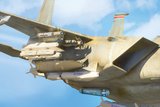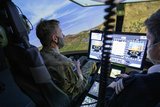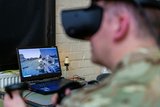Expanding the envelope – Global Hawk set for capabilities enhancements (Studio)
This article is brought to you in partnership with Northrop Grumman
Northrop Grumman is looking to the future of the RQ-4 Global Hawk unmanned aircraft system (UAS), with technological upgrades, new customers and an expanding mission set all in its sights.
The Global Hawk has been in active operation with the US Air Force (USAF) since 2001, when its entry into service was accelerated in the wake of the September 11 terrorist attacks.
This relationship is set to continue for the foreseeable future, with Northrop Grumman recently announcing a new contract mechanism with the USAF called ‘Epic II’.
Beginning in Fiscal Year 2021, Epic II will keep the platform flying to 2030 and beyond, said Deputy Program Director John Salafia, allowing for upgrades, improvements and enhancements as required.
The system has also had success in the international market, having been ordered by the Republic of Korea, Japan, and for NATO’s Alliance Ground Surveillance (AGS) system.
As technology evolves and the demands on the platform increase, Northrop Grumman is pursuing development work in a number of core areas, Salafia said.
ABOVE: The first Global Hawk flight from Edwards Air Force Base in California in February 1998.
Its top priority is the Ground Station Modernization Program (GSMP). The ground station is a key element of the UAS, serving as the primary interface between pilots, sensor operators and the vehicle.
After almost 20 years of service, the ground stations face growing challenges with diminishing manufacturing sources (DMS), when replacement parts or components are no longer available.
GSMP will address this by introducing more modern equipment, while improving the overall quality and performance of the ground stations in a range of key areas.
There are now three major configurations of Global Hawk, each of which has a different mix of payloads.
— Author
Northrop Grumman is also working with its partners to expand and enhance Global Hawk’s sensor offerings.
This area has evolved in a number of directions over the years, Salafia said. There are now three major configurations of Global Hawk, each of which has a different mix of payloads.
The multi-intelligence (‘multi-int’) variant comes with an enhanced integrated sensor suite (EISS) that includes a synthetic aperture radar and an electro-optical/infrared (EO/IR) camera.
The second variant focuses on wide area surveillance, and has a version of the Multi-Platform Radar Technology Insertion Program (MP-RTIP) radar system, similar to that found on the company’s E-8 Joint Surveillance and Target Attack Radar System (JSTARS).
The final variant – the Battlefield Airborne Communications Node (BACN) – is designed to provide communications to disadvantaged users, such as soldiers on the ground.
Northrop Grumman is working to broaden this range, Salafia said, through the deployment of the MS-177 Multi-Spectral Sensor, which is being produced by Collins Aerospace.
This will provide more detailed imagery than is available from an EO/IR camera, Salafia said.
Operational testing is now complete, he added, with the USAF expected to make a fielding decision by the end of the year. Northrop Grumman is also working on a new generation of the sensor – MS-177A – that will add additional spectral bands to the system, providing even greater depth for analysts.
ABOVE: An EQ-4 Global Hawk equipped with the Battlefield Airborne Communications Node (BACN) payload.
The Global Hawk has a level of autonomy that is unique in the unmanned domain, flying to mission-engineered plans based on objectives, targets, sensor types and other information.
The pre-planned nature of this capability means the user essentially needs only to click a mouse to start the engine, taxi, take off and perform the mission, Salafia said.
While there is always a “pilot in the loop” with the capacity to intervene if needed, ‘the system is capable of autonomously performing its mission’.
This autonomy dimension has been a key area of evolution for Global Hawk over its years in service, Salafia added, with the company working closely with the user community to optimise the capability to their advantage.
ABOVE: Northrop Grumman developed a system to allow for quicker sensor changes on the aircraft - initially called the Universal Payload Adapter, now the USAF calls it the IPA (ISR Payload Adapter).
As a high-altitude long endurance (HALE) platform, Global Hawk can fly for 24-30 hours without refuelling, loitering over areas and taking imagery, among other tasks.
While its military applications are well known, these capabilities could be useful in a growing range of other areas in the future, said Salafia.
The system has already been used during national emergencies; Salafia expects this to expand going forward, with Global Hawks providing the earliest possible imagery for first responders in typhoons, earthquakes, tsunamis and other disasters.
Likewise, Salafia highlighted Global Hawk’s use as a communications node for militaries on the battlefield. This could easily be adapted to the humanitarian domain, providing ‘essentially a flying cell tower to re-establish communications in an area’.
These applications stem from Global Hawk’s inherent capabilities to fly, loiter, and endure for long time periods, with the ability to conduct observations in any role.
‘Anything where you need observation for a long amount of time, Global Hawk can do,’ he said. ‘There’s a great opportunity for a system like this to grow into other kinds of missions.’
More from Studio
-
![Combat-proven capabilities: How precision-strike systems are evolving for tomorrow’s battlespace (podcast)]()
Combat-proven capabilities: How precision-strike systems are evolving for tomorrow’s battlespace (podcast)
Combat-tested technology is being reshaped to counter A2/AD threats, reduce reliance on GPS and enable faster, more autonomous targeting in complex environments. In this special podcast, experts explain how the evolving threat landscape is shaping next-generation strike capabilities.
-
![Energy evolution: How laser defence systems are powering the next phase of air defence (podcast)]()
Energy evolution: How laser defence systems are powering the next phase of air defence (podcast)
Laser-based air defence is moving from promise to deployment as global threats evolve. In this special podcast, we explore how high-energy laser systems are reshaping interception strategies.
-
![Intelligence advantage: How real-time GEOINT is reshaping military decision-making (Studio)]()
Intelligence advantage: How real-time GEOINT is reshaping military decision-making (Studio)
In today’s contested operational environment, adaptability is key. The new Geospatial-Intelligence as a Service (GEO IaaS) solution from Fujitsu and MAIAR empowers militaries by enabling intelligence advantage, combining advanced technology with human expertise to deliver actionable insights.
-
![Training Together: Unlocking Educational Excellence through Military and Industry Collaboration (Studio)]()
Training Together: Unlocking Educational Excellence through Military and Industry Collaboration (Studio)
Military training is ultimately about people. At Capita, training programmes are built on close engagement with partners, delivering an educational approach that can adapt to individual needs, cultivate leadership – and drive wider cultural change.
-
![Enhancing Military Training Through Digital Technology (Studio)]()
Enhancing Military Training Through Digital Technology (Studio)
Digital technologies offer huge opportunities for defence training. However, militaries must adopt an agile approach, placing the needs of their organisations and personnel at the centre of their efforts.
-
![Layered Defence: How new technologies are enhancing armoured vehicle survivability and manoeuvrability (Studio)]()
Layered Defence: How new technologies are enhancing armoured vehicle survivability and manoeuvrability (Studio)
As modern threats evolve, armoured fighting vehicles face a new era of challenges, from loitering munitions to kinetic energy projectiles. Advances in active, passive, and reactive protection systems are crucial to ensuring battlefield dominance, freedom of manouver and vehicle survivability.

























